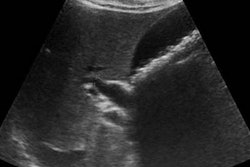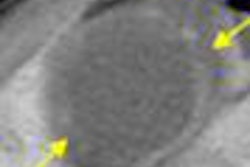
CT was found to be considerably more accurate than ultrasound at identifying acute cholecystitis in a new study, published in the August issue of the American Journal of Roentgenology. But is that enough evidence for CT to oust ultrasound as the imaging modality of choice? Probably not, say researchers from New Mexico.
Ultrasound is widely considered the first-line imaging exam for evaluating acute cholecystitis -- a gallbladder infection most commonly caused by gallstones, according to lead author Dr. Joss Wertz and colleagues from the University of New Mexico. However, the reported accuracy of the modality varies widely in relevant studies and is marked by notably low sensitivity (as low as 50%) and specificity (bottoming out at 33%).
In this retrospective study, Wertz and colleagues compared the diagnostic accuracies of ultrasound and CT for acute cholecystitis in patients at Raymond Murphy Veterans Affairs Medical Center from July 2013 to July 2015. Among the 42 patients with acute cholecystitis who underwent both imaging exams, a radiologist correctly identified the condition in 35 patients on CT scans compared with only 27 patients on ultrasound scans (AJR, August 2018, Vol. 211:2, pp. 92-97).
Overall, the diagnostic accuracy of CT was higher than that of ultrasound to a statistically significant degree (p = 0.043). The readers did not tag any false positives on either CT or ultrasound scans.
| Ultrasound vs. CT for diagnosing gallbladder infection | ||
| Ultrasound | CT | |
| Sensitivity | 68% | 85% |
| Specificity | 100% | 100% |
| Negative predictive value | 78% | 90% |
| Positive predictive value | 100% | 100% |
Furthermore, the researchers assessed a number of additional cases in which patients underwent only one of the two imaging exams. They found that radiologists who read ultrasound scans missed approximately 21% of cases of acute cholecystitis, whereas those who read the CT scans did not miss any.
Though CT demonstrated a marked advantage over ultrasound in terms of diagnostic accuracy, part of the difference may have been due to the high proportion of poor-quality ultrasound exams and the lack of a consensus on the definition of a positive imaging exam for acute cholecystitis, the authors noted. In addition, CT comes with the downsides of radiation exposure and a relatively high cost.
"Ultrasound is still our first test of choice if acute cholecystitis is suspected clinically, whereas CT is performed when the clinical picture is unclear," they wrote, adding, however, that ultrasound and CT are complementary. "If the initial test is negative and there is clinical suspicion of acute cholecystitis, or if the initial examination is equivocal, the other examination should be performed."



















